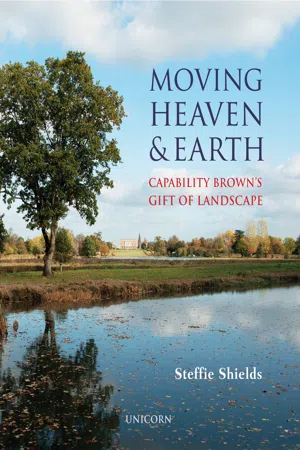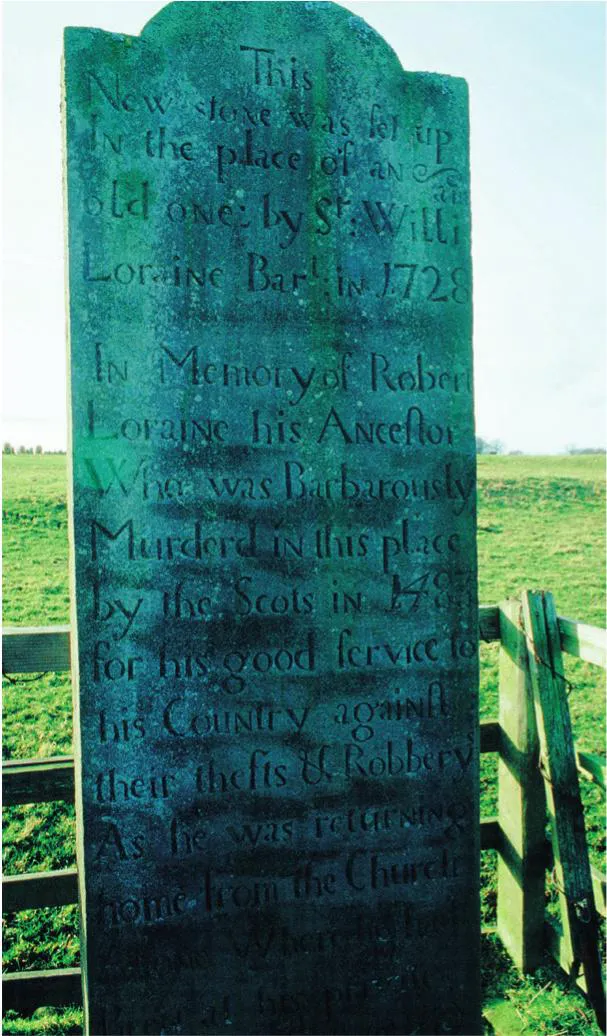
This is a test
- 240 pages
- English
- ePUB (mobile friendly)
- Available on iOS & Android
eBook - ePub
Book details
Book preview
Table of contents
Citations
About This Book
This beautifully illustrated book, with the vast majority of illustrations photographed by the author, makes a fitting tribute to the world-famous 18th century landscape architect Lancelot 'Capability' Brown (1716-1783) in his Tercentenary year. Moving Heaven and Earth reveals the driven polymath behind the famous nickname. It explores both Brown's artistic legacy and his pioneering work with water in the landscape. The book evaluates the rise of the English landscape garden in the climatic context of his designs and also forms a comprehensive guide for tours and visits. Approximately 350 clearly labelled colour photographs, pin-point Brown's enduring views and surprisingly vibrant planting palette.
Frequently asked questions
At the moment all of our mobile-responsive ePub books are available to download via the app. Most of our PDFs are also available to download and we're working on making the final remaining ones downloadable now. Learn more here.
Both plans give you full access to the library and all of Perlego’s features. The only differences are the price and subscription period: With the annual plan you’ll save around 30% compared to 12 months on the monthly plan.
We are an online textbook subscription service, where you can get access to an entire online library for less than the price of a single book per month. With over 1 million books across 1000+ topics, we’ve got you covered! Learn more here.
Look out for the read-aloud symbol on your next book to see if you can listen to it. The read-aloud tool reads text aloud for you, highlighting the text as it is being read. You can pause it, speed it up and slow it down. Learn more here.
Yes, you can access Moving Heaven and Earth by Steffie Shields in PDF and/or ePUB format, as well as other popular books in Architecture & Urban Planning & Landscaping. We have over one million books available in our catalogue for you to explore.
Information
Topic
ArchitectureSubtopic
Urban Planning & LandscapingCHAPTER ONE
NORTHUMBERLAND

February 1988, Holy Island, Northumberland Lindisfarne Castle warmed by late-afternoon sun.
No one lives in Northumberland without being touched by its wild terrain. High hills unfold beneath vast skies. Ever-changing light accentuates infinite sweeps of craggy, wind-whipped moorland, punctuated by dense stands of Scots pine protecting lonely farmsteads.
Rugged slopes of coarse tufted grass are dotted with thousands of sheep. Warmed in season by gorse, heather and bracken, the hills are silent in winter, their contours softened by pillows of snow. Space and solitude reign.
This ancient territory, north of the River Humber, colonised by Romans, converted by fervent monks and Holy Island saints, was once claimed as a kingdom by invading Norsemen. Eastward, in place of Viking invaders, castles and abandoned ruins command endless, empty stretches of coastal dune.
Inland, the raids of the Border reivers long since history, granite peel towers and fortified farmhouses, or ‘bastles’, continue to stand guard over small farming communities.
This is Border Country, the ‘back pocket of England’,12 home to Northumbrian pipes, fireside stories and gentle humour, a land of singular charm and majesty, the birthplace of Lancelot ‘Capability’ Brown.
Little of Brown’s early life is recorded. As far as is known, his parents, Ursula and William Browne, were tenant farmers.13 They moved down from Elsdon, a rough and lawless reivers’ community above Redesdale, to peaceful grazing land some ten miles further south-east. Kirk Harle,14 their small village (now a hamlet called Kirkharle), on the ancestral estate of the Loraine family, nestled in the secluded valley of the River Wansbeck. Here, in 1716, the second youngest of their six children was born one (unrecorded) summer’s day.
On 30 August 1716 (probably soon after the birth) the baby boy was christened Lancelot in St Wilfrid’s, a fourteenth-century church, little more than a chapel.
Four years later, his father William died. At about this time, Sir William Loraine, 2nd Baronet (1658–1744), a barrister and one-time MP for Northumberland, inherited the estate. It seems likely that he developed a close, supportive relationship with the bereaved Brown family, since he later became the children’s patron and first employer.
This Brown’s schooldays were spent in Cambo village some three miles north-east of his home. He followed his older brothers John and George to the plain, stone-built schoolhouse, where the Master, Thomas Gastle, was much respected. All three Brown boys achieved professional status, but Lancelot, by all accounts, was particularly quick to learn, eager for any opportunity for self-improvement.
On the daily three-mile trek to and from school he crossed the Wansbeck, pausing to watch comings and goings at the largest country house in the neighbourhood. A wealthy Whig, Sir Walter Blackett, had inherited the Wallington estate and immediately began building. Lancelot witnessed great changes, especially when grandiose new stables were commissioned and his brother, George, was taken on as builder and mason. George assisted the architect Daniel Garrett (d.1753), who had worked for Richard Boyle, 3rd Earl of Burlington (1694–1753), well known for his Palladian taste. Brown was intrigued, and certainly stimulated, as Gateshead nurseryman William Joyce improved the grounds with widespread plantations.

TOP RIGHT July 1989, Kirkharle, Northumberland Later in his life, Brown suggested adding the bell-cote to the fourteenth-century St Wilfrid’s Church.
ABOVE February 2000, Kirkharle, Northumberland Traces of eighteenth-century parkland planting surround Kirkharle Hall, with the Cheviot Hills in the distance. The road (left) leads to St Wilfrid’s Church. My camera lens has flattened the view, but I was pleased to see new tree-planting since my last visit.

TOP LEFT July 1989, Cambo, Northumberland (NT) The Old Schoolhouse now bears a stone memorial plaque dedicated to its most famous pupil, Lancelot Brown.
ABOVE April 1990, Wallington Hall, Northumberland (NT) Brown went to school in Cambo village above Wallington Hall in the picturesque Wansbeck Valley. Later, in the 1760s, he gave advice to improve Wallington’s grounds. A few traces of his planting remain, for instance on the hill behind the house.
Closer to home, Loraine at Kirk Harle set about planting: ‘24,000 forest trees, 480,000 quicks, 580 fruit trees, divided his grounds, built new farmhouses, drained morasses, cleared land of ponderous stones for the village’.15
The local community admired him for his learning, and especially for the garden fountains and fishponds he installed, ‘the first regular ones known in that country’.16
In 1728, Loraine decided to replace an old monument on the hill near his house. As a twelve-year-old, Brown may have watched, or even helped to position the restored stone. The inscription reads:
This new Stone was set up in place of an old one by Sr Will. Loraine Bart. in 1728 In Memory of Robert Loraine, who was barbarously murdered in this place by the Scots in 1483 for the good service to his Country against their thefts and Robbery as he was returning home from the Church.
On leaving school, Lancelot followed his eldest brother John into employment on the Loraine estate. He received basic training in the cultivation of fruit trees, the art of hedging and the practicalities of trenching, creating drainage for tree plantations that improved the views from the manor house. This is where he was well grounded in both levelling and fieldwork, learning to assess and survey the land.

February 2000, Kirkharle, Northumberland Despite the peaceful rural setting, the Loraine Memorial is a disturbing reminder of man’s barbarity.
Every Brown landscape repays exploration and offers surprise – rounded hill and hollow, cascading burn and sinuous pool, hanging wood and hidden grotto, a grown-up ‘hide and seek’. Wherever he worked he recreated, perhaps subconsciously, the open, undulating countryside of his boyhood, dominated by the ever-present hills, Cheviot and Hedgehope.
Weather was a challenging factor in farming, gardening and lake-making initiativ...
Table of contents
- Cover
- TITLE PAGE
- DEDICATION
- CONTENTS
- PREFACE
- INTRODUCTION
- CHAPTER ONE: NORTHUMBERLAND
- CHAPTER TWO: MR BROWN ENGINEER
- CHAPTER THREE: THE FINEST GARDEN
- CHAPTER FOUR: CLIENTS, SURVEYS & PROPOSALS
- CHAPTER FIVE: CONTRACTS & ASSOCIATES
- CHAPTER SIX: GROUNDWORK
- CHAPTER SEVEN: LAKE-MAKING
- CHAPTER EIGHT: RIVERS REAL & ILLUSORY
- CHAPTER NINE: CASCADES
- CHAPTER TEN: PROBLEMS & PUMPS
- CHAPTER ELEVEN: ROYAL GARDENER AT HAMPTON COURT
- CHAPTER TWELVE: PAINTS AS HE PLANTS
- CHAPTER THIRTEEN: NOW THERE I MAKE A COMMA
- CHAPTER FOURTEEN: SHRUBBERY ‘SWEETS’ & FLOWER GARDENS
- CHAPTER FIFTEEN: COMFORTS & CONVENIENCE
- CHAPTER SIXTEEN: FREEDOM TO ROAM
- CHAPTER SEVENTEEN: KEEP ALL IN VIEW VERY NEAT
- CHAPTER EIGHTEEN: MOVING HEAVEN
- CHAPTER NINETEEN: THE ‘KITCHING GARDEN’
- CHAPTER TWENTY: FULL-SCALE DRAMA
- CHAPTER TWENTY-ONE: ADVERSITY OF MAN & NATURE
- CHAPTER TWENTY-TWO: TRANSITION
- CHAPTER TWENTY-THREE: THE MYSTERY OF THE GARDEN
- CHAPTER TWENTY-FOUR: LOVE OF COUNTRY
- CHAPTER TWENTY-FIVE: EPILOGUE
- APPENDIX
- BIBLIOGRAPHY
- NOTES
- INDEX
- ACKNOWLEDGEMENTS
- COPYRIGHT